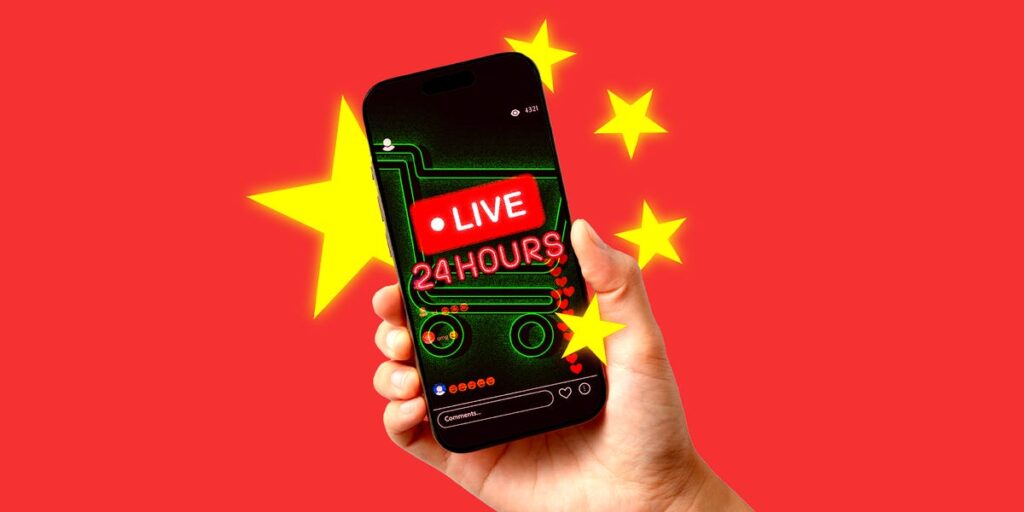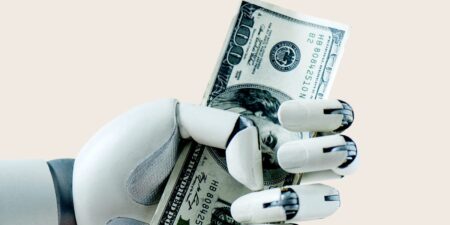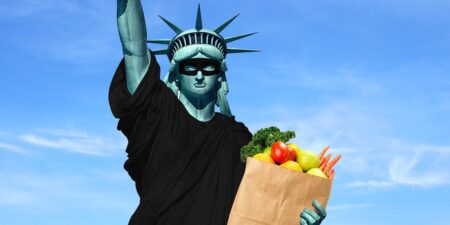Andrew Martin lit up his bedroom-turned-content creation studio with warm lights ahead of a Prime Day stream.
During the hourlong session in October, Martin, a UK-based livestreamer who posts on Amazon Live in the US, demonstrated the range of a wireless microphone. He got up from his desk, settled down comfortably on a sofa behind him, surrounded by cat perches and cozy ambient lights.
“I fancy doing the stream from the chair here,” he joked to his viewers. “I don’t need to be on that computer, do I? Get me a little can, I’ll sit here and have a drink.”
Martin said people tune into his streams to get good deals on electronics and to talk with him casually about life over the platform’s live chat function.
He is part of a group of livestreamers who promote products on live shows on platforms such as Amazon Live, eBay Live, TikTok Shop, and others.
A typical stream involves a host touting products, offering their opinions, answering viewers’ questions in real time, and also releasing special deals and discounts.
This mode of shopping, which has proven hugely successful in China, is gaining popularity in the US, and e-commerce giants are cashing in.
How livestreaming won in China
Livestreaming in China is light-years ahead of the West.
Ron Wardle, the former CEO of China-based e-commerce company ExportNow, said livestream commerce took off in China in 2018, after Alibaba’s founder, Jack Ma, challenged beauty influencer Austin Li to sell more lipsticks than him on Alibaba’s e-commerce platform, Taobao Live.
Li earned the title of China’s “Lipstick King” after he sold 15,000 lipsticks in five minutes, beating Ma’s sales.
Now, Li has amassed a following of 35 million on Douyin, parent company ByteDance’s local version of TikTok.
His daily streams on Taobao feel like sensory overloads, with an endless array of banners and colorful pop-ups. In one of his most famous streams, he tested 380 lipsticks over a seven-hour stream.
Live shows like Li’s are “part shopping, part variety show,” said Jacob Cooke, the CEO of Beijing-based e-commerce consulting firm WPIC Marketing + Technologies.
“Live shows blend entertainment, discovery, and transaction in real time,” Cooke told Business Insider. “The format creates a shared social moment — millions watching, commenting, asking questions — that static listings can’t replicate.”
Cooke added that livestreaming in China got a leg up during the pandemic, when livestreams “became a way to replicate the social experience of shopping at a mall.”
Exclusive vouchers, countdowns, and limited-quantity flash deals gamify shopping, prodding users to spend more and spend fast.
And Taobao’s livestreams never sleep, running 24/7.
When Business Insider checked Taobao at 10:30 a.m. in China, there was a steady stream of live shows taking place on the app. Online shops, big and small, hawked everything from press-on nails and hair ties to umbrellas.
Livestreams also help people decide what to buy, Cooke said, as the livestream hosts filter choices and translate complex specifications.
This mode of selling is particularly effective for goods where “demonstration, trust, or impulse play a big role,” he said, such as beauty products, cosmetics, skincare, trendy clothing, and small electronics.
The US is now catching on
In the past two years, livestreaming has picked up steam in the US.
TikTok said in December that during the Black Friday and Cyber Monday weekend in 2024, TikTok Shop — which relies heavily on livestreaming — saw a 165% increase in shoppers compared to the year before. The weekend drove $100 million in US sales.
Livestream shopping app Whatnot, which focuses on collectibles, announced in January that it had raised $265 million in its Series E funding round, bringing its valuation to $4.97 billion.
And a September 2024 survey by digital commerce company VTEX found that 45% of 1,000 US adults surveyed had browsed or bought products from live shopping events on sites like Poshmark or Amazon in the year leading up to the study.
Short-form video platforms have created a space for interactive and shoppable content, and brands are taking advantage of this.
“American consumers — especially younger cohorts — want entertainment, discovery, and social proof in their shopping, which should allow livestreaming to grow,” Cooke said.
The collectibles boom is firing up the livestreaming industry
The collectibles boom is also driving the livestreaming industry.
Collectibles of all sorts — board games, Pokémon trading cards, blind box toys like Labubu — are flying off the shelves, sought after by a consumer group called “kidults.”
And livestreaming is the collectible sellers’ mechanism of choice. They often film product unboxings and prove the authenticity of the collectibles in real time in front of a camera.
Business Insider tuned into a Utah-based livestream of Pokémon trading cards on eBay Live. The stream, which had about 50 viewers, showed a seller running through a deck of more than 50 cards, briefly describing each one over energetic, high-BPM music.
Hagglers bargained over the prices. When the seller ripped open the plastic covering from a new card deck, viewers flooded the screen with likes.
Jamie Iannone, eBay’s CEO, said in a September episode of “Opening Bid” that eBay is confident about the future of livestreaming because collectibles are a $10 billion business for the company annually.
“eBay Live is still a nascent product, but one we think has a lot of potential,” Iannone said on the podcast.
Why livestreamers are seeing it as a viable career path
For livestreamers, the career path offers flexible working hours, remote work, and a chance to make money from their interests.
Caleb Wessels, a 34-year-old beauty livestreamer from Vancouver, used to work as a makeup artist in a chain drug store.
During the pandemic, when he couldn’t put makeup on people, he said he was picked by Amazon to be a creator on Amazon Live.
It was easy to get started — he already had ring lights and cameras.
“Anyone can jump in. You can do it with your iPhone if you want to,” he said. He does not have a fixed livestreaming schedule and starts streaming when he feels like it.
The platform allowed him to keep sharing makeup tips and swatch products for viewers.
He said he loves interacting with people, some of whom ask him personal questions unrelated to products and deals.
During one of his Amazon Live livestreams in October, Wessels answered questions from viewers about Amazon Prime Day deals, as well as some friendly regulars who asked him about his coming wedding.
Martin, the electronics livestreamer from the UK, said his streams are “quite relaxed,” and he usually gets asked about his filming equipment.
For both Martin and Wessels, the commissions they receive from their livestreams are not enough to make ends meet.
Wessels said that apart from his livestreams, he also does a part-time AI training gig to supplement his income. The number of livestreamers on Amazon Live has increased since he joined in 2020, which he says diluted his audience.
“So many more people are trying to livestream at the same time, it’s spread the audience,” Wessels said. “So I went from sometimes hitting a hundred thousand viewers, to now, numbers that are much lower.”
Martin said that while he occasionally generates livestream sales, he focuses more on creating content for platforms like YouTube, where viewers can watch it at their own pace.
“It hardly pays me anything at the moment, but as long as I can pay my bills and feed my cats, that’s enough for me,” Martin said of his livestreaming sales.
Read the full article here
















